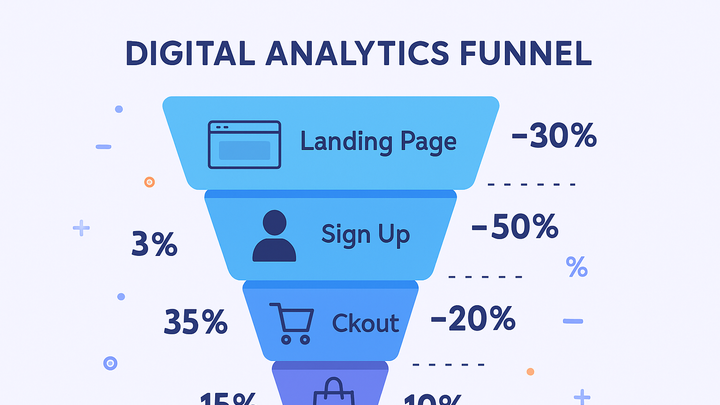Published on 2025-06-27T20:54:10Z
What is a Funnel? Examples of Funnels in Analytics
Funnel in Analytics
A funnel in analytics is a series of defined steps that users take toward a specific goal—such as signing up, purchasing, or downloading. Funnels help teams visualize user progression, measure drop-offs, and calculate conversion rates at each stage. By identifying bottlenecks, businesses can optimize the user journey to increase efficiency and revenue. Modern analytics platforms like Google Analytics 4 (GA4) and PlainSignal support funnel analysis through event tracking and custom visualizations. PlainSignal’s cookie-free snippet enables lightweight tracking for privacy-focused sites without sacrificing insight.
Example PlainSignal Tracking Code:
<link rel="preconnect" href="//eu.plainsignal.com/" crossorigin />
<script defer data-do="yourwebsitedomain.com" data-id="0GQV1xmtzQQ" data-api="//eu.plainsignal.com" src="//cdn.plainsignal.com/plainsignal-min.js"></script>
Funnel
A funnel visualizes a user’s journey through defined steps to measure conversion and identify drop-offs in analytics.
Why Funnels Matter in Analytics
Funnels are critical for understanding how users progress through a predefined series of steps. They help you identify where users drop off and optimize conversion flows.
-
Identify bottlenecks
Funnels reveal drop-off points where significant user attrition occurs, allowing targeted improvements.
-
Measure conversion rates
By comparing the number of users who complete each step, you can calculate conversion rates and overall funnel efficiency.
-
Optimize user journey
Insights from funnel analysis guide UX and content optimization to smooth transitions between steps.
Key Components of a Funnel
Every funnel consists of stages, conversion metrics, and drop-off rates. Understanding these components is necessary to build and interpret funnels effectively.
-
Stages
Individual steps defined in a user journey, from first interaction to final goal completion.
-
Entry point
The first step where users enter the funnel, such as a landing page or product page.
-
Intermediate steps
Actions like adding to cart or initiating checkout.
-
Goal completion
The final desired action, such as purchase or sign-up.
-
-
Conversion rate
The percentage of users who move from one stage to the next.
-
Drop-off rate
The percentage of users who leave the funnel at each stage.
Implementing Funnels in GA4
Google Analytics 4 provides built-in funnel analysis via the Explorations feature and Tracked Events. GA4 funnels are flexible and can include multiple segments.
-
Define events and parameters
Ensure that key user actions are tracked as events with relevant parameters in GA4.
-
Create a funnel exploration
In GA4, navigate to Explorations > Funnel analysis, then add steps based on events.
-
Customize funnel settings
Adjust funnel type (open or closed), conversion window, and segment comparisons.
Implementing Funnels in PlainSignal
PlainSignal offers cookie-free analytics with simple event tracking. Setting up a funnel involves adding their snippet and defining steps in the dashboard.
-
Add PlainSignal tracking code
Embed the PlainSignal snippet on your site before the closing </head> tag.
-
Code snippet
<link rel="preconnect" href="//eu.plainsignal.com/" crossorigin /> <script defer data-do="yourwebsitedomain.com" data-id="0GQV1xmtzQQ" data-api="//eu.plainsignal.com" src="//cdn.plainsignal.com/plainsignal-min.js"></script>
-
-
Define funnel steps
In the PlainSignal dashboard, select events or pageviews as funnel steps and assign names.
-
Analyze funnel reports
Use the funnel visualization to see conversion paths and drop-offs at each step.
Best Practices for Funnel Analysis
Effective funnel analysis follows consistent naming, limited steps, and segmentation to provide clear insights.
-
Use consistent event naming
Standardize event names and parameters across the site to avoid confusion.
-
Limit the number of steps
Keep funnels concise (3–5 steps) to maintain clarity and actionability.
-
Segment your funnels
Break down funnels by user attributes (e.g., traffic source, device) to uncover deeper insights.
-
Test and iterate
Regularly review funnel performance and make incremental improvements based on findings.
